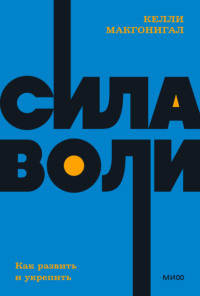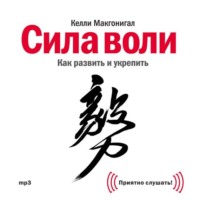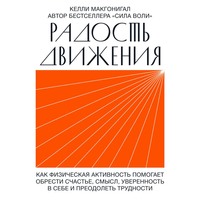
Полная версия
Радость движения. Как физическая активность помогает обрести счастье, смысл, уверенность в себе и преодолеть трудности
19
Meghan K. Edwards and Paul D. Loprinzi. “Experimentally Increasing Sedentary Behavior Results in Increased Anxiety in an Active Young Adult Population.” Journal of Affective Disorders 204 (2016): 166–173; Meghan K. Edwards and Paul D. Loprinzi. “Effects of a Sedentary Behavior – Inducing Randomized Controlled Intervention on Depression and Mood Profile in Active Young Adults.” Mayo Clinic Proceedings 91, № 8 (2016): 984–998; Meghan K. Edwards and Paul D. Loprinzi. “Experimentally Increasing Sedentary Behavior Results in Decreased Life Satisfaction.” Health Promotion Perspectives 7, № 2 (2017): 88–94.
20
Tim Althoff et al. “Large-Scale Physical Activity Data Reveal Worldwide Activity Inequality.” Nature 547, № 7663 (2017): 336–339.
21
См.: Bramble and Lieberman. “Endurance Running and the Evolution of Homo”; Herman Pontzer. “Economy and Endurance in Human Evolution.” Current Biology 27, № 12 (2017): R613–621; Jay Schulkin, “Evolutionary Basis of Human Running and Its Impact on Neural Function.” Frontiers in Systems Neuroscience 10 (2016): 59.
22
Herman Pontzer. “The Exercise Paradox.” Scientific American, February 2017. Цитата на с. 27.
23
Tiina Saanijoki et al. “Opioid Release After High-Intensity Interval Training in Healthy Human Subjects.” Neuropsychopharmacology 43, № 2 (2018): 246–254; Henning Boecker et al., “The Runner’s High: Opioidergic Mechanisms in the Human Brain.” Cerebral Cortex 18, № 11 (2008): 2523–2531.
24
Patrick M. Whitehead. “The Runner’s High Revisited: A Phenomenological Analysis.” Journal of Phenomenological Psychology 47, № 2 (2016): 183–198.
25
David A. Raichlen et al., “Exercise-Induced Endocannabinoid Signaling Is Modulated by Intensity.” European Journal of Applied Physiology 113, № 4 (2013): 869–875.
26
David A. Raichlen et al. “Wired to Run: Exercise-Induced Endocannabinoid Signaling in Humans and Cursorial Mammals with Implications for the ‘Runner’s High.’” Journal of Experimental Biology 215, № 8 (2012): 1331–1336.
27
Angelique G. Brellenthin et al. “Endocannabinoid and Mood Responses to Exercise in Adults with Varying Activity Levels.” Translational Journal of the American College of Sports Medicine 2, № 21 (2017): 138–145; E. Heyman et al. “Intense Exercise Increases Circulating Endocannabinoid and BDNF Levels in Humans – Possible Implications for Reward and Depression.” Psychoneuroendocrinology 37, № 6 (2012): 844–851; P. B. Sparling et al. “Exercise Activates the Endocannabinoid System.” NeuroReport 14, № 17 (2003): 2209–2211; M. Feuerecker et al. “Effects of Exercise Stress on the Endocannabinoid System in Humans Under Field Conditions.” European Journal of Applied Physiology 112, № 7 (2012): 2777–2781.
28
Цитируется по: Elizabeth Cassidy, Sandra Naylor, and Frances Reynolds. “The Meanings of Physiotherapy and Exercise for People Living with Progressive Cerebellar Ataxia: An Interpretative Phenomenological Analysis.” Disability and Rehabilitation 40, № 8 (2018): 894–904.
29
Роман Стивена Кинга и одноименный фильм ужасов; в центре сюжета – собака по имени Куджо, заболевшая бешенством. Прим. пер.
30
David Fleming. “Slow and Steady Wins the Planet.” ESPN, February 11, 2011; http://www.espn.com/espn/news/story?id=6110087.
31
Adharanand Finn. “Why We Love to Run.” The Guardian, February 5, 2013; https://www.theguardian.com/lifeandstyle/the-running-blog/2013/feb/05/why-we-love-to-run.
32
Robin Christensen et al. “Efficacy and Safety of the Weight-Loss Drug Rimonabant: A Meta-Analysis of Randomised Trials.” The Lancet 370, № 9600 (2007): P1706–1713.
33
Hamilton Morris. “New Frontiers of Sobriety.” Vice, July 31, 2009; https://www.vice.com/en_us/article/kwg8ny/new-frontiers-of-sobriety-984-v16n8.
34
Brooke K. Keeney et al. “Differential Response to a Selective Cannabinoid Receptor Antagonist (SR141716: Rimonabant) in Female Mice from Lines Selectively Bred for High Voluntary Wheel-Running Behaviour.” Behavioural Pharmacology 19, № 8 (2008): 812–820; Sarah Dubreucq et al. “Ventral Tegmental Area Cannabinoid Type-1 Receptors Control Voluntary Exercise Performance.” Biological Psychiatry 73, № 9 (2013): 895–903.
35
Johannes Fuss et al. “A Runner’s High Depends on Cannabinoid Receptors in Mice.” Proceedings of the National Academy of Sciences of the USA 112, № 42 (2015): 13105–13108.
36
Eli Puterman et al. “Physical Activity and Negative Affective Reactivity in Daily Life.” Health Psychology 36, № 12 (2017): 1186–1194.
37
Andreas Ströhle et al. “The Acute Antipanic and Anxiolytic Activity of Aerobic Exercise in Patients with Panic Disorder and Healthy Control Subjects.” Journal of Psychiatric Research 43, № 12 (2009): 1013–1017.









